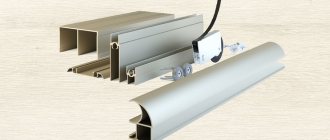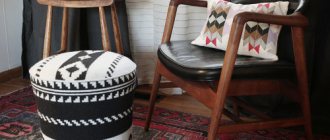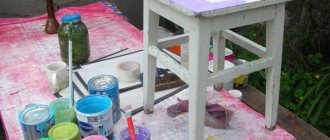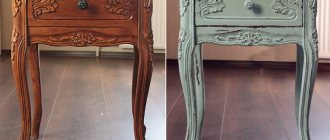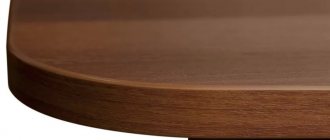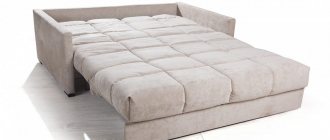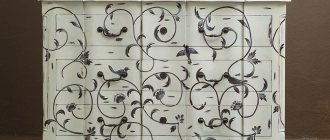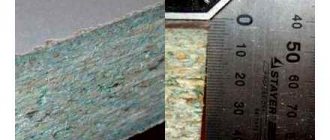How to cover an ottoman with fabric (do-it-yourself furniture restoration)
Quite often, our favorite items, which we use for a relatively long time, lose their original appearance or simply become boring. Sometimes it happens that you want to make repairs and update the interior of a room, but at the same time not part with your favorite piece of furniture, which in its style or color does not fit into the new design. And if we are talking about such items as soft poufs, it is enough to change their covering, and they will be able to please you for many years, making your life more comfortable and cozy. By upholstering the pouf with new fabric and soft lining, you will receive a completely new piece of furniture that will fully correspond to its style and your taste. If you don’t yet know how to cover a pouf yourself, then this article is for you.
Features of ottomans and their role in the interior
The main features of a soft and comfortable ottoman include:
- due to its height and small size, the product can be easily moved from one room to another;
- Thanks to the soft seat, the product has special comfort;
- ottomans can be easily adjusted to any interior style; just cover them with fabric that will organically fit into the overall decor;
- The market provides a large number of different models and options for poufs.
Reference! There are also transformable ottomans on sale in which you can store some small things.
Role in the interior
What can be said about their main role:
- if you put a pouf in the living room, you can place a guest on it;
- in the bedroom, a pouf can be an excellent replacement for a bedside table;
- if the item lives in a children's room, it can become a small storage area for toys and a comfortable chair;
- using a pouf in the hallway you can easily put on your shoes;
- if the pouf does not have a too soft surface, it can be used as a replacement for a tea table.
This is such a multifunctional and convenient thing.
Choosing fabric for covering the ottoman
To cover the ottoman, you need to choose the right material. By upholstering the ottoman with new fabric and soft lining, you can get a completely new piece of furniture that will match your style and taste. First, you need to choose what stylistic decision the upholstery of the soft pouf will be made in. When choosing a fabric, you need to pay attention to the texture and its density, you can take the fabric: How to cover an ottoman with your own hands? For a classic design, a product covered in satin or brocade-like fabric is perfect. To create a room in ethnic style, a pouf made of matting will look good.
You can also make patchwork-style upholstery from several pieces of thick fabric in contrasting colors. You can cut out identical pieces from them and sew them together. The result is a bright and stylish ottoman seat.
The sides of the chair covers can be cut from a plain fabric that matches the color shade of one of the patches.
Advice from professionals
In order to update the ottoman cover, you need to baste fabric patterns together and stitch them on a sewing machine. After all the parts are sewn together, you should cut off the excess fabric and smooth out the seams using an iron. Then you should trim off any excess seam allowances to ensure that the cover fits snugly.
The bottom edges should be hemmed by machine or by hand, then ironed. Next, you need to unscrew the cover and put it on the ottoman, straightening out the folds. If desired, the pouf can be decorated. For example, you can sew a large button into the middle of a seat made of scraps, covering it with decorative material to match the color of the sides.
Attention: You can sew ruffles and lace onto the ottoman - this option is suitable for a bedroom or children's room. If you sew on a fringe, you can create an interior element that will perfectly suit the design of a baroque or classic room.
Subscribe to our Social networks
Low price calculator for reupholstery
Type: Sofa Corner sofa Armchair Armchair (soft armrests) Chair (soft back) Chair (without soft back) Kitchen corner Banquette Pouf
Stages of reupholstering ottomans
Restoration work on ottomans and banquettes is carried out in the following order:
- Preparation. The client brings the upholstered furniture to the workshop or coordinates the arrival time of a measurement specialist. Based on the inspection results, the material is selected, the timing and cost of the work are calculated.
- Furniture dismantling. The technician dismantles the old sheathing and old filler if it has been subject to wear or damage.
- Making upholstery. When sewing a new fabric, old fabric is used as a pattern, which guarantees high accuracy of the tightening.
- Assembling the pouf. Soft filling is laid and the ottoman is reupholstered using new fabric.
- Quality checking. Upon completion of furniture repairs, specialists carry out quality control through a thorough inspection of the product. Next, we will coordinate the time for picking up the furniture if the work was carried out at the workshop.
What you need
After determining the fabric, the question arises of what is needed to upholster the ottoman.
Materials, tools and patterns
For ease of work, for example, take a square pouf.
Reference! Due to its convenient shape, the covering process is very quick and simple.
The user will need:
- pencil;
- ruler;
- paper;
- scissors;
- needles;
- pins;
- thread;
- sewing machine;
- textile.
Filler and decorative components are selected as desired and necessary.
Work technology
In order to make a frame for a pouffe from sheets of chipboard or plywood, you need to make patterns from the prepared material according to its dimensions:
- According to the size of the seat, you should cut out a piece of foam rubber;
- You should measure and then add the width of the sides of the pouf;
- Based on the measurements obtained, taking into account the height of the product, you should cut out a piece of padding polyester and cover the sides with it;
- Then you need to secure the padding polyester using a special stapler.
To make the work easier, you should first apply special glue to the walls of the frame. The foam rubber for the seat should be prepared in the same way. Patterns pre-cut from upholstery material must be stapled to a soft base, tucking in at the edges.
Drawing with dimensions
Before you start making an ottoman with a chipboard lid, you need to calculate its dimensions in advance, select manufacturing materials, and think through the design. After this, it is recommended to make a drawing with all dimensions on a piece of paper.
Tip : Having a drawing will simplify the work process and will prevent you from mixing up parts or spoiling consumables.
Choice of design and construction
When deciding on the structure of the accessory, you should build on your own abilities and skill in needlework. For those who master carpentry skills, it will not be difficult to make a multifunctional wooden product with many convenient drawers.
Experienced seamstresses can easily create a designer ottoman of any size, shape and color.
For those who do not have special skills, it is better to get by with a frameless accessory made from simple materials. Tires, a regular household bucket or a wooden box are ideal for this.
When choosing the external design of an ottoman, you should take into account the overall interior design. The classic style is perfectly complemented by a simple accessory made of wood. The upholstery should ideally be made of expensive fabric, such as velvet or silk. Luxurious fringe cords will also luxuriously complement the product.
For apartments with a more modern design, a pouf with leather or fur upholstery is ideal. Accessories with an abstract print or an original patch will look interesting. Also, the decor in the Art Nouveau style will be perfectly complemented by a plain soft ottoman in a bright color.
Why do you need spare covers?
Additional removable covers can be made
Having spare “clothes” will always keep your furniture clean. In addition, this is a great opportunity to change the situation. The interior of your home will be significantly transformed if you sew several covers and periodically put them on poufs. Also, such a decision will create your reputation as a caring and practical housewife. After all, you must admit that it is much easier to remove and wash a cover than to remove stains from its upholstery. This is especially true if there are small children in the house.
Any handmade products look original and attract attention. They add coziness to the apartment and create a special atmosphere. So if you want to update your interior and save yourself the hassle, sew one or more ottoman covers.
How to choose fabric for covering a pouf
If the user decides to upholster the ottoman on his own, then the first step is to decide on the fabric. If you want the upholstery to be durable and the pouf to have a presentable appearance, then the best option would be leather or its substitutes. If the main role that the pouf will perform is sitting, then it is best to give preference to soft fabrics.
In other options you can use:
- tapestry;
- suede;
- velor;
- velvet.
These are the most optimal and common options for upholstering any ottomans.
Replacing upholstery for a pear chair
Puff pear
If your favorite beanbag chair has lost its former beauty due to wear and tear of the fabric on the outer shell, then you will have to restore the ottoman. You, of course, can throw it away and buy a new one, but believe me, repairing it will be a more pleasant and less expensive task than buying a new bag.
If the inner burlap is in good condition, and the filling has not shrunk and still holds the shape of the chair, then you can quickly update the product.
The simplest option is to remove the old cover from the bag and, in accordance with the shapes and sizes of its wedges, cut out new pieces of fabric. To do this, we select a dense and strong material for the new outer shell of the bag, make a pattern and sew all the parts together from the wrong side. Then we cut off all excess fabric, steam the seams with an iron and turn the product inside out. We sew in a zipper and update our old pear ottoman by putting a new and beautiful outer cover on it.
Using the same principle, you can sew a stylish and fashionable ottoman from old jeans. It will look pretty good in a children's room or youth apartment. To do this, you will need several pairs of unnecessary jeans and a great desire to sew an ottoman out of them.
If you already have burlap with filling, all you have to do is make a pattern on paper, examples of which can be easily found on the Internet, and transfer it to pieces of jeans that have been previously ripped at the seams.
When choosing a pattern, keep in mind that the width of the bean bag chair wedges should be no larger than the width of the pant legs.
Next, according to the scheme familiar to us - you sew together all the wedges of the bag, sew on the base, steam the seams, turn the fabric inside out, sew on a zipper and put the denim cover on the bag with the filling.
Now you know how to cover an ottoman at home with your own hands and you can easily give new life to your old, but very beloved, soft and cozy pieces of furniture.
Sizes and shapes of poufs
They used to call a pouf a small, plump chair with short legs. The modern market offers the consumer a huge assortment, which does not stop at the choice of color and upholstery material.
- Big ones. They are more reminiscent of a full-fledged chair in size, but their external resemblance to a small pouf does not allow them to be called that. Such poufs give the room a more comfortable appearance and adjust the overall feel;
- Mini poufs. Such babies are often present in children's rooms or placed in hallways, making it easier for household members to change shoes.
- Square. These are classic ottomans that are distinguished by their cubic shape. Most often, these models are equipped with covers.
- Rectangular. Another favorite option for the hallway, because such poufs are not only easy to put on shoes, but also to store shoes.
- Round. This is what is considered a classic of the genre. It is precisely these ottomans that once gained popularity and are not losing ground to this day.
- Curly. A current option for decorating a child’s room, as these types of poufs have interesting shapes and bright designs.
Ottoman cover
The process of tightening the ottoman is one of the most important stages of creative work, which requires special care and patience.
To carefully and beautifully upholster a homemade accessory you will need:
- Upholstery material (to your own taste);
- Sintepon;
- Foam rubber;
- Furniture stapler;
- Super glue.
First of all, you need to make a soft foam base for the seat. Then cut out a rectangle from padding polyester that corresponds to the height and width of all four sidewalls in total. Cover it with a thick layer of glue and glue it to the frame. To make the structure more durable, it is recommended to secure it with a furniture stapler.
The final stage of creative work is, in fact, covering the resulting accessory with the selected material. To do this, you need to cut blanks that correspond to the dimensions of the seat, sides and bottom. In this case, you must leave a few centimeters on each side for the fold. You can attach the resulting blanks to the ottoman using a furniture stapler. The resulting ottoman can be trimmed with various ribbons and other decorations.
This way you can transform not only a homemade accessory, but also an old shabby ottoman, making it sparkle with new colors!
We put a cover on the ottoman
Turn the finished cover inside out and iron it. Now you can put the cover on the ottoman. The old upholstery can be removed if desired. But, if there is not too much damage on it and they do not occupy a large area, it is not necessary to remove it.
Place the ironed cover on the ottoman. Fold the bottom seam allowance to the bottom of the ottoman. Bend it inward by 1-2 cm so that it does not fray in the future. Secure the allowance in this position with furniture nails and staples.
DIY plastic pipe ottoman
Consider a master class on making an ottoman from plumbing pipes
.
First the pipes are cut
into pieces approximately thirty centimeters long. You will need about nine of these pieces.
Color
pipes with gold acrylic paint. It is necessary to paint in several layers. Allow each layer to dry for about twenty minutes before applying a new one.
Top painted surfaces are treated
protective varnish. This makes it resistant to water.
The pipes are secured with an adhesive gun. The glue will set quickly, so everything must be done without delay.
Polyurethane mats
for the bathroom, they are folded in half and cuts are made in them along the perforations. The length of the cuts is approximately five centimeters.
The rug is rolled up and a kind of bud is obtained.
Such rolls with buds are inserted into pipes. They should fit tightly. In this case, additional fastening will not be necessary.
The result is an original ottoman that will look great in the bathroom.
Required materials and tools
Chipboard ottomans are very popular. Such designs can withstand heavy loads and can be used as a full-fledged stool. They may also have different design features. This may be a hinged lid design or other options. In any case, to build a simple chipboard ottoman you will need:
- Chipboard sheet. Its size should be 240x175x1.6 cm. You can also use plywood. Its thickness should not be less than 1.3 cm. This will be enough for the ottoman to be used by adults.
- Beam with a section of 4x4 cm and a length of 150 cm.
- If desired, the product can be made on wheels. In this case, you will need 4 videos.
- If the ottoman is made with a hinged lid, then 2 more hinges will be needed.
- Foam rubber or padding polyester is used as filler.
- Tapestry or other dense fabric is suitable for upholstery.
As for the tools, to make an ottoman with your own hands you will need:
- a hacksaw with fine teeth or a jigsaw, which will allow you to efficiently cut chipboard or plywood;
- hammer;
- self-tapping screws;
- screwdrivers or screwdriver;
- construction stapler or furniture nails with wide heads;
- wood glue.
To simplify and speed up the process, you can use a box with legs. It is made of bars that are connected to each other with self-tapping screws. But what could be better than a homemade square ottoman on wheels with a hinged lid. Thus, the structure will be used not only for sitting, but also for storing various small items or toys. A step-by-step master class will show how easy it is to organize the production of such furniture at home.
A brief excursion into history
An ottoman or ottoman is a low item that belongs to the category of upholstered furniture that is designed for people to sit. It is also sometimes used as a footstool, or may even just serve as a decoration for the room. The shapes of the products are varied, but most often there are square and round ottomans, completely covered with upholstery fabric, except perhaps for the legs, which are usually made of wood.
Vintage delightful ottoman
Before we talk about how to make such a piece of furniture ourselves, let's study the history of this product. So, the history of the ottoman and furniture in general are very closely intertwined. The very first ottomans appeared in Ancient Egypt, and a little later they began to be used in rich homes in Greece and Rome.
English ottoman stand
Over the many years that ottomans have existed, they have changed dramatically. Previously, leather, fur, wood, and expensive fabrics were used to make poufs. Sometimes the pouf could have a beautiful design - such beautiful products can still be seen in museums. But gradually the popularity of richly decorated poufs faded away (around the Middle Ages). This was due to the promotion of an ascetic lifestyle, which the Catholic Church was actively involved in. Rougher and harder seating options began to appear, and sometimes people even sat on simple benches or chests. Separate chairs were only used by the nobility.
Antique ottoman with legs
Around the 18th century, beautifully decorated upholstered poufs came back into use in Europe. And this was facilitated by the fact that aristocrats could afford to decorate their homes with exquisite products, and asceticism faded into the background. Elegant poufs became popular among ladies who did not have to wrinkle their luxurious dresses to sit on them. So the ottoman was a frequent “guest” at the ball.
The pouf in its modern form, as we know it now, appeared around the end of the 19th century in France. And since then it has been and remains a popular piece of furniture.
You can make a pouf with your own hands quite simply
On a note! In Europe, this piece of furniture is called a pouf, but in Russia the more affectionate word “ottoman” has taken root.
Drawings of ottomans
It is inconvenient to make ottomans with your own hands from a photo - drawings are usually used for work. First you need to determine the shape of the product; for this you use your imagination or simply take popular options. There are classic round, square, rectangular ottomans and lamzak-type bags (pancake- or pear-shaped).
Important! The presence of a back on the ottoman is not necessary, but it will increase the comfort of the finished structure. The design of a standard rectangular ottoman with a lid is the simplest
The size of the product depends on personal wishes. Be sure to immediately think about a cover for the ottoman - preferably removable and washable.
Soft ottomans are universal, the main thing is to strictly follow the dimensions in the drawings. An ottoman with a hinged lid is a more functional model, which will provide additional storage space.
Basic requirements for ottomans
There are no requirements as such when choosing an ottoman for the hallway, but there are certain recommendations that need to be followed so that the product does not disappoint the owner.
- The ottoman should match the style and shape of the interior.
- It should be mobile and lightweight if you plan to move it frequently.
- It is better to choose environmentally friendly materials so that there is no risk of getting an allergic reaction or any disease. This primarily applies to people who have weak immunity or are allergic to anything.
- It is important to consider the size of the free space in the room. The ottoman should complement the hallway, and not occupy the last free corner and disturb everyone.
- As for the type of pouf, it is important to take into account the free space, the wishes of the owner of the hallway and other factors.
- You should not make an ottoman with sharp corners, especially if children live in the apartment. In any case, sharp corners increase the risk of injury to both children and adults.
Ottoman in the hallway - photo
Cylindrical product
The user can also independently make a pouf from plywood and give it a cylindrical shape.
Assembly from base
The algorithm is simple:
- according to the desired dimensions, two identical circles are cut out of plywood;
- then the side walls are cut out: several narrow plywood elements.
Advice! The best option is to take 25 planks, it will not take so long to install and at the same time the shape of the cylinder will be beautiful.
Assembly
Having prepared and processed the parts, you can proceed to assembly:
- plywood boards are attached in a circle using special glue;
- then fastening occurs using self-tapping screws;
- after attaching them to one of the round bases, the workpiece is turned over;
- the second disk is generously smeared with glue along the edges and the finished product is attached to it;
This completes the work process.
How to make something hard soft
To do this, you need to wrap the cylindrical blank in several layers of soft fabric.
This will help smooth out all the sharp corners and make the future pouf more pleasant.
Expert advice on the process of reupholstering a soft ottoman yourself
How to quickly and easily make a pouf, expert advice.
Sanding and painting the base
How to paint and sand the base for an ottoman yourself. Sanding and painting the pouf is necessary in cases where the product will not be covered with fabric. If the boards are too rough, you will have to carry out the sanding procedure yourself. To do this, sandpaper will come to the aid of the craftsman. And if you want to save time, then it is best to use a grinding machine.
To paint a pouf, the paint itself is not important, the color and base are the work of the craftsman himself. The main thing is that the coloring material is suitable for wood.
Installation of legs for an ottoman
Reference! The easiest option is to purchase legs at a hardware store and screw them on using self-tapping screws. A more complex option is to make it yourself.
In order to make legs for a pouffe, a craftsman must cut the desired shape from a wooden block, process it and paint it using special paints. But it is worth considering that the legs should be painted at the same time as the base, and nothing else. Another option: roller wheels.
How to make an ottoman from a plastic bucket
Frame: DIY Lily Ardor / YouTube
What you will need
- Plastic bucket with flat lid;
- fabric for the cover;
- fleece;
- padding polyester;
- a piece of tourist foam or polyethylene foam;
- glue gun;
- construction stapler;
- scissors;
- ruler;
- needle;
- threads;
- pencil;
- chalk.
How to do
If the bucket has a handle, remove it; you won't need it.
Frame: DIY Lily Ardor / YouTube
Using scissors, cut the fleece lengthwise into wide strips. You also need to cut out two circles from it, repeating the size of the bottom and lid of the bucket.
Frame: DIY Lily Ardor / YouTube
Apply glue to the bucket and wrap fleece strips around it until it has the correct cylindrical shape, without any protrusions. If the container is initially flat, then just a few turns of the fabric will be enough, just to make the ottoman soft.
Frame: DIY Lily Ardor / YouTube
Glue a layer of padding polyester on top of the fleece.
Frame: DIY Lily Ardor / YouTube
Attach the edges of the padding polyester to the bottom of the bucket.
Frame: DIY Lily Ardor / YouTube
Glue a fleece circle cut to fit the bottom over the folded edges of the padding polyester so that the bottom of the ottoman looks neat.
Frame: DIY Lily Ardor / YouTube
Place the lid of the bucket (or any other suitable size disk) on the foam and trace it with a pencil.
Frame: DIY Lily Ardor / YouTube
Cut out the circle along the resulting outline.
Frame: DIY Lily Ardor / YouTube
Glue the foam to the lid.
Frame: DIY Lily Ardor / YouTube
Wrap the lid with padding polyester and secure it on the back with a stapler.
Frame: DIY Lily Ardor / YouTube
Measure the height and circumference of the ottoman bucket. Lay a strip on the cover fabric, adding 5–6 cm to the width, and cut it out.
Frame: DIY Lily Ardor / YouTube
If the edges of the fabric are fraying, overcast them or fix them with glue. Trim off the excess.
Frame: DIY Lily Ardor / YouTube
Wrap the fabric of the cover around the ottoman so that the extra width falls on the top of the product, and firmly sew the edges of the panel with thread.
Frame: DIY Lily Ardor / YouTube
Carefully glue the edges of the cover to the fleece bottom of the ottoman.
Frame: DIY Lily Ardor / YouTube
Wrap the excess fabric inside the bucket and attach it to the sides.
Frame: DIY Lily Ardor / YouTube
Glue a strip of fleece over the folded edge.
Frame: DIY Lily Ardor / YouTube
Place the bucket lid on the fabric from the cover and draw a circle with a radius 10 cm larger than it. Cut it out.
Frame: DIY Lily Ardor / YouTube
Wrap the lid into the resulting circle and fold the edges of the material over it.
Frame: DIY Lily Ardor / YouTube
Secure in the middle with three or four staples. This is necessary to temporarily fix the fabric; they will need to be removed later.
Frame: DIY Lily Ardor / YouTube
Carefully staple the fabric around the entire circumference of the lid, retreating approximately 3 cm from the edge. After this, remove the temporary staples in the center.
Frame: DIY Lily Ardor / YouTube
Peel off excess fabric.
Frame: DIY Lily Ardor / YouTube
Glue a fleece circle on top that fits the lid to disguise the staples and cut edges.
Frame: DIY Lily Ardor / YouTube
You can watch the full instructions in this video:
What other options are there?
You can decorate an ottoman made from a bucket with a carriage tie:
Or give it this original two-part shape:
Simplified diagram for making an ottoman
If you have neither the time nor the desire to work with patterns, use this suggested option.
1. Cut out two circles of the same size from the material, not forgetting the seam allowances. This will be the bottom and top of the pouf.
2. Also cut out two identical rectangles. The length of the rectangle should be equal to half the circumference of the circle. The width of the rectangle is the height of the pouf.
3. Sew two rectangles on one side along the width from the wrong side. A long braid will come out.
4. Baste stitched rectangles to the circle bases, and then stitch. An uneven or sloppy seam can be trimmed with decorative braid.
5. Sew a zipper into the remaining unstitched edge of the rectangle and place the printed material. The ottoman is ready without wasting time.
The result of making a children's ottoman
Using this pattern, you can sew a pouf in the shape of a cube. The only difference is that the parts are cut out in a square shape. The sides will now consist of 4 parts. Sew these pieces together. If you use braid that contrasts the color of the base material, the edges of the cube will be clearer.
Stylish ottomans in the form of cubes
The best fabric is thick, it will give strength, and the pouf will keep its shape, for example, felt.
Advantages of furniture restoration
Even the most thrifty housewife's furniture becomes unusable over time. To avoid throwing it away, you can resort to simple steps that will make the furniture last for many more years. Among the advantages of furniture restoration are:
- after the process, you will have new furniture in your apartment that can be used for many years;
- If the process is carried out correctly, you can get rid of scratches, chips, and dents formed during operation.
Any furniture that is in your home has the right to a second life, and you, in turn, can realize this by resorting to the simplest techniques.
Knitted cover
If you don’t have a sweater in your closet that you are willing to sacrifice, but you love to do needlework, you can knit “clothes” for your furniture. Such things look especially cozy in winter, as they create the impression of warmth and comfort. If you knit well, the process will not take you much time. Perhaps all you need to do is sit in front of the TV for a couple of evenings - and the product is ready!
Regular garter stitch will do. Choose your favorite thread color. It is better if the yarn is mostly synthetic (70% acrylic, 30% wool). The product will not stretch or shrink when washed, and it is much easier to care for. If your ottoman is square or rectangular, knit two pieces of the desired size with knitting needles. On average, one centimeter of garter stitch is two loops. This way you can calculate the number of loops based on the width of the pouf. Throw on 4-6 loops so that the parts can be sewn together and the pouf fits freely into the finished product. In this case, the cover will be put on top. There is no need to sew on the bottom.
